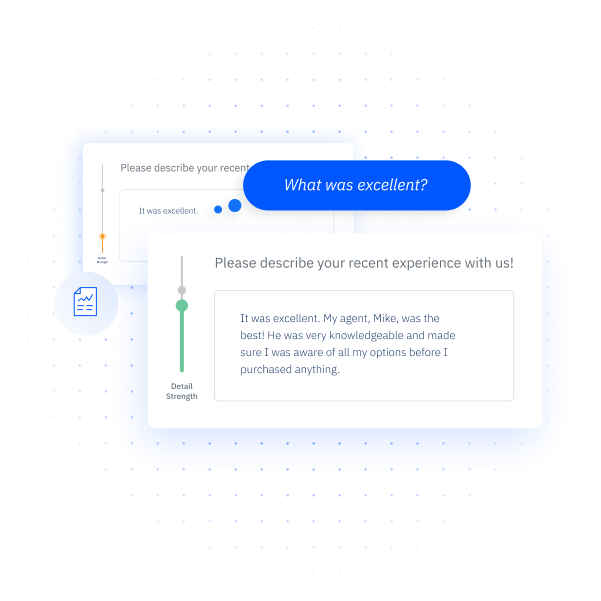Conversational Surveys: A Game-Changer in Feedback Collection
Conversational surveys are surveys designed to feel like a natural conversation rather than traditional survey questionnaires. With advanced AI, it enables an interactive approach to gathering more detailed customer feedback beyond the standard response of good, bad, or okay.
Conversational surveys are revolutionizing how businesses gather customer feedback by creating engaging, personalized interactions that resonate with all age groups, from Gen Z to Gen X. These dynamic surveys adapt their follow-up questions based on responses, enhancing engagement and encouraging more comprehensive survey participation.
This innovative approach not only improves customer experience but also yields richer, actionable insights that empower businesses to refine their strategies. Discover how Conversational AI can transform your customer feedback process and help your business thrive.
What are Conversational Surveys?
Conversational surveys represent a modern approach to collecting customer feedback, transforming the experience from a static questionnaire into a dynamic conversation. These surveys use Conversational AI to mimic natural human dialogue, making the feedback process more interactive and engaging for respondents.

With InMoment’s customer feedback software, respondents are 2.4x times more likely to leave actionable verbatim feedback. A higher engagement level can help you find areas where improvements will greatly impact CX. As a result, businesses can see a quicker ROI on customer experience.
How Do Conversational Surveys Differ from Traditional Surveys?
Traditional surveys typically follow a rigid format. Respondents must go through a set order of questions, regardless of their responses. This impersonal approach can lead to high drop-off rates and often results in incomplete or superficial responses.
In contrast, conversational surveys are designed to feel more like a two-way interaction. Using chat interfaces or conversational AI, these surveys adjust their questions based on the respondent’s previous answers.
This creates a more personalized and engaging experience. Conversational surveys encourage respondents to provide more detailed feedback. They also make the process feel more natural and less stressful.
Our conversational AI helps respondents 24% more likely to share valuable insights into their intentions. This opens more pre-emptive opportunities for engagement. By fostering a natural, open dialogue, it enables businesses to anticipate customer needs and respond proactively, strengthening connections and driving impactful customer interactions.
How are Conversational Surveys Beneficial for Businesses?
Conversational surveys offer several key benefits for businesses looking to elevate their customer experience:
- Higher-Quality Feedback Collection: Conversational surveys talk to customers in a more natural way. This approach can collect up to 5x more actionable data compared to traditional methods. The flexibility of these surveys allows them to dive deeper into customer sentiments and uncover valuable insights that might otherwise be missed.
- Faster Issue Resolution: With features like InMoment’s Rapid Resolution Engine, conversational surveys can identify and address customer issues in real-time, often before they escalate. This proactive approach not only enhances customer satisfaction but also reduces the volume of inquiries reaching your support team.
- Enhanced Customer Experience and Satisfaction: By offering a more personalized and engaging feedback process, conversational surveys help foster stronger connections with customers. This, in turn, boosts loyalty and encourages repeat business.
- Lower Support Costs: Channel deflection through conversational surveys means fewer issues escalate to costly customer service interactions. This efficiency translates to significant cost savings for businesses.
Our conversational survey has proven highly beneficial for our clients, with respondents leaving 70% more words in their feedback. Additionally, feedback related to customer effort increased by 17%. This gives your team a clear view of friction points along the customer journey. These added details provide richer insights, empowering your teams to take more personalized and impactful actions that truly resonate with customers.
How Do Conversational Surveys Work?
Conversational surveys work by utilizing advanced AI technologies to create a more interactive and responsive feedback experience. Tools like InMoment’s Active Listening AI engage with respondents in real time, prompting them with follow-up questions based on their initial answers. This approach not only keeps the conversation going but also ensures that the feedback gathered is detailed and contextually rich.
As customers provide feedback, the Rapid Resolution Engine analyzes their responses and identifies any underlying issues. It then offers immediate solutions, such as a helpful tutorial or video, directly within the survey. This seamless integration of feedback collection and problem-solving helps businesses elevate customer experience by addressing concerns before they become larger issues. Learn how the features of Active Listening and Rapid Response can elevate the customer experience.

Examples of Conversational Surveys
Conversational surveys can take many forms, depending on the context in which they are used. For example:
- Chat Surveys: These surveys use a chat interface to interact with customers. They might appear in the survey question itself, as a chat window on a website, or within an app, where the customer can provide feedback in a conversational style.
- SMS Surveys: Similar to chat surveys, SMS surveys engage customers through text messages, asking questions, and collecting responses in real-time.
- In-App Feedback: Embedded within mobile apps, these surveys can pop up at key moments in the customer journey, such as after completing a purchase or using a new feature, to gather immediate feedback.
How to Analyze Data from Conversational AI Surveys?
Conversational surveys are a powerful tool for gathering richer, more insightful customer feedback. Here are a few key steps to analyze conversational survey data effectively to enable your business to drive meaningful improvements in customer experience:
- Organize and Structure Responses: Start by categorizing responses based on topics, sentiments, and themes. Use natural language processing (NLP) tools or text analysis software to automate some of this categorization, grouping feedback by intent, emotion, or keywords.
- Sentiment Analysis: Apply sentiment analysis to determine the tone (positive, negative, or neutral) of responses. This step can help identify areas where customers are either satisfied or frustrated, allowing teams to prioritize areas for improvement.
- Thematic Analysis: Identify recurring themes, such as product features, service issues, or general experience. Text analytics can cluster feedback into topics, providing an overview of common areas customers mention. With conversational surveys, this might include tracking how often intent-driven words or phrases appear.
- Intent Analysis: Intent analysis goes beyond sentiment by identifying the purpose behind responses. For instance, customers may express a desire to buy, get support, or provide feedback. Recognizing these intents helps businesses identify pre-emptive engagement opportunities.
- Generate Actionable Insights: Use dashboards and reporting tools to transform raw data into visual summaries, allowing CX teams to quickly identify actionable insights. Regular reports that highlight emerging trends or urgent issues keep stakeholders informed and aligned.
However, with a surge of detailed responses, CX managers and teams face the challenge of efficiently analyzing it all. Depending on the volume, it can take weeks or even months to sift through feedback, delaying critical improvements that enhance customer satisfaction and demonstrate ROI. This bottleneck can slow your team’s ability to deliver impactful results, affecting overall business outcomes.
Empower your CX team to focus on implementing impactful strategies instead of getting bogged down in time-consuming analysis. That’s where InMoment’s text analytics solutions come in. With our advanced software, you can uncover rich insights in minutes rather than weeks. Our text analytics models identify 54% more topics, enabling your team to discover improvement opportunities with remarkable scale and precision.
How to select the right conversation survey solution?
Choosing the right conversational survey solution involves several key considerations:
- Customization: Ensure the solution allows you to tailor surveys to reflect your brand’s voice and meet the specific needs of your audience.
- Integration: The solution should easily integrate with your existing platforms, such as CRM systems, to streamline feedback collection and analysis.
- AI Capabilities: Look for advanced AI features like Natural Language Processing (NLP) and machine learning, which can enhance the quality of insights gathered from your surveys.
- Data Security & Compliance: It’s crucial to choose a solution that keeps your data secure and complies with local regulations, especially if you operate in multiple regions.
InMoment’s Conversational Surveys are available to all existing customers at no extra cost. Reach out to your Customer Success Manager to start leveraging this powerful tool. If you’re new to InMoment, schedule a demo. With InMoment’s Conversational Surveys, you’ll collect richer insights, resolve issues faster, and boost customer satisfaction—all while enhancing your bottom line.




